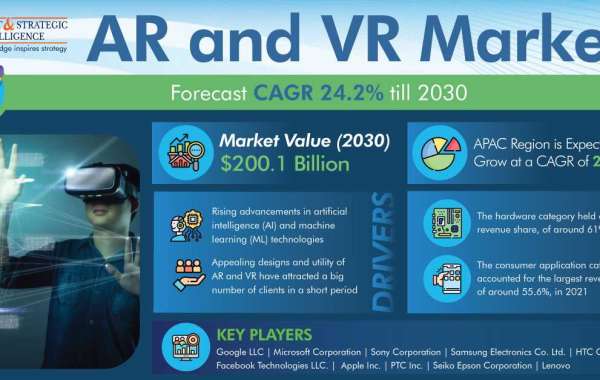The augmented reality (AR) and virtual reality (VR) market value stood at $37.0 billion in 2019, and it is predicted to surge to $1,274.4 billion by 2030, demonstrating a CAGR of 42.9% from 2020 to 2030 (forecast period). The major factors fueling the expansion of the market are the growing use of AR and VR technologies in the entertainment, tourism, healthcare, education, and gaming sectors. Additionally, the falling costs of these technologies, on account of several advancements and innovations, are also contributing toward their booming popularity around the world.
Rapid technological advancements in the domain of optics, including light-field technology, are predicted to fuel the development of flexible, affordable, and compact displays for smart glasses and headsets. Presently, the players operating in the industry are providing software development kits (SDKs) to application developers at highly affordable prices. Because of the growing adoption of these technologies, the cost of products will fall massively in the coming years. Furthermore, many businesses operating in various industries are increasingly focusing on adopting AR and VR technologies in order to improve their operations.
For instance, The Boeing Company witnessed a massive reduction in its wiring production time by as much as 25% and error rate after the adoption of smart glass displays. Major application developers, device manufacturers, and solution providers are targeting businesses owing to the wide application base provided by them. Depending on type, the AR and VR market is divided into AR and VR categories. Between these, the VR category contributed higher revenue to the market in the years gone by. This was because of the large-scale adoption of VR in several industries, particularly gaming, and falling costs of VR devices.
The VR technology provides a highly immersive experience to users and thus, enterprises, especially those operating in the business sector, are incorporating these features into their services and products for luring customers. When application is taken into consideration, the AR and VR market is classified into commercial, consumer, and enterprise. Out of these, the enterprise category is expected to register rapid expansion in the coming years. Many businesses are already benefiting from VR and AR in several ways, such as improved learning outcomes, optimized productivity, efficient logistics and warehousing, effective collaboration with various remote workers, and real-time data visualization and analysis.
For instance, Volkswagen AG and DHL International GmbH are utilizing Google LLC’s Glass Enterprise Edition as a productivity improvement tool. Geographically, the AR and VR market will demonstrate the fastest growth in the Asia-Pacific (APAC) region in the coming years, as per the estimates of the market research company, PS Intelligence. This is credited to the rapid technological revolution in the region. Additionally, the presence of a vast tech-savvy population and growing popularity of AR and VR-based gaming are also propelling the advancement of the market in the region.
Hence, the demand for AR and VR technologies will soar all over the world in the years to come, primarily because of the ability of these technologies to provide a highly immersive experience to users and the rising requirement for improved productivity and efficiency among businesses.








